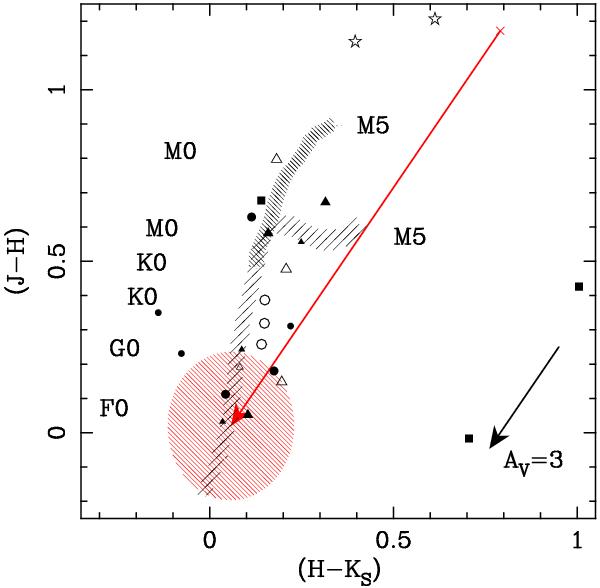Fig. 8

Near-IR colour–colour diagram of quiescent classical nova systems reproduced from Figs. 4 and 7 in Hoard et al. (2002) using Table 1 of their data. The figure is adjusted to include the quiescent 2MASS colours of the nova V1721 Aql system. The light cross-hatched area represents near-IR colours of main sequence stars with the denser cross-hatched area representing the giant branch (see references within Hoard et al. 2002). The black points show individual nova systems and are coded according to the time since outburst, τ, as follows; filled squares: τ < 25 years; filled triangles: τ = 25−50 years; open triangles: τ = 50−75 years: filled circles: τ = 75−100 years; open circles: τ > 100 years. The star-shaped points are the recurrent nova systems. The nova systems presented here have not been corrected for extinction as in most cases the reddening is not accurately known, but it is assumed to be small to negligible in the near-IR for most Galactic novae systems. The large points for individual nova systems have 1σ uncertainties of ≤ 0.1 mag, smaller points have 1σ uncertainties of > 0.1 mag. The red cross represents the observed quiescent near-IR colours of the V1721 Aql nova system. The red line indicates the system’s reddening vector with the arrowhead indicating its near-IR colours once corrected for an extinction of AV = 11.6. The region enclosed by the red cross-hatching indicates all colours the nova system could possess within the error circle of AV = 11.6 ± 0.2. A de-reddening vector corresponding to AV = 3 is also shown.
Current usage metrics show cumulative count of Article Views (full-text article views including HTML views, PDF and ePub downloads, according to the available data) and Abstracts Views on Vision4Press platform.
Data correspond to usage on the plateform after 2015. The current usage metrics is available 48-96 hours after online publication and is updated daily on week days.
Initial download of the metrics may take a while.


